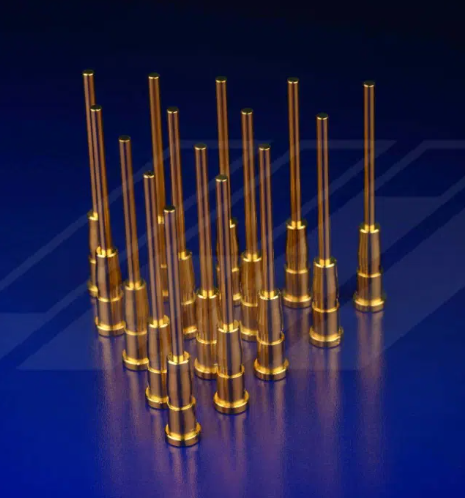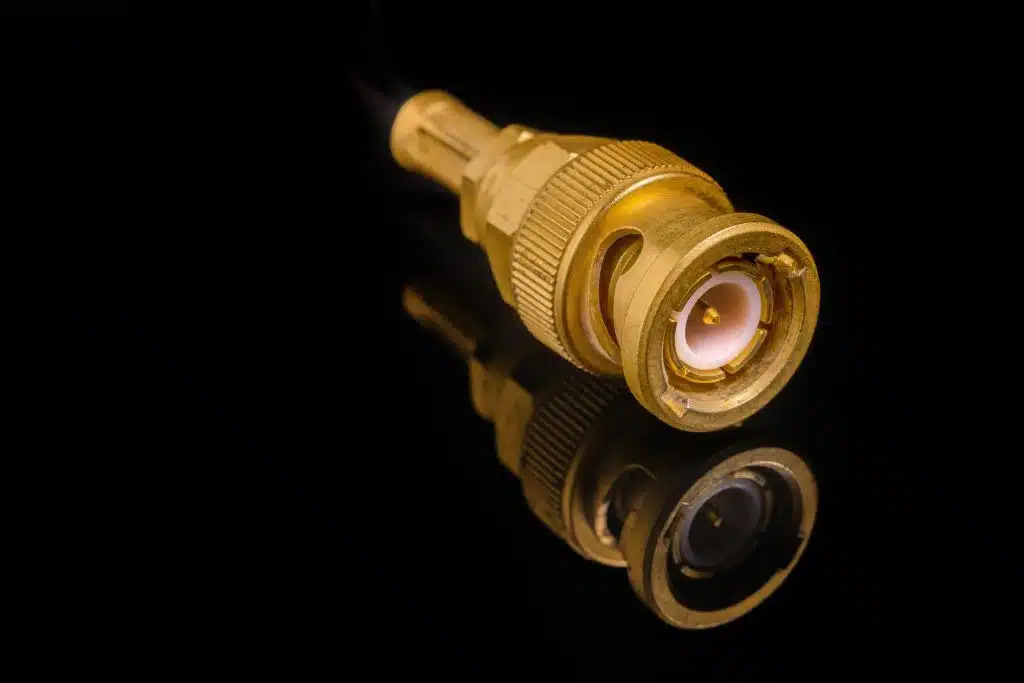Soft gold plating is a game-changer for high-frequency connector performance. It ensures low contact resistance, excellent corrosion resistance, and reliable signal transmission, making it an ideal choice for demanding applications like telecommunications, aerospace, and data centers. In this blog, we’ll explore why soft gold plating for high-frequency connectors is essential, diving into its benefits, optimal thickness, and impact on connector durability and performance.
What is Soft Gold Plating and Why Does It Matter?
Soft gold plating refers to a thin layer of pure gold applied to connector contacts through an electroplating process. Unlike hard gold, which contains additives for durability, soft gold is nearly 99.9% pure, offering superior conductivity and flexibility. This makes it perfect for high-frequency connectors where signal integrity is critical.
High-frequency connectors operate at speeds often exceeding 1 GHz, handling signals for applications like 5G networks, satellite communications, and high-speed data transfer. At these frequencies, even tiny losses or interferences can degrade performance. Soft gold plating addresses these challenges by minimizing signal loss and ensuring stable connections over time.

The Role of Soft Gold Plating in High-Frequency Connector Performance
Connector performance in high-frequency applications hinges on several factors: signal integrity, impedance control, and durability. Soft gold plating enhances all these aspects. Let’s break down how it contributes to connector performance with soft gold plating.
1. Superior Signal Integrity
In high-frequency systems, signal integrity is everything. Any distortion or loss can lead to data errors or reduced system efficiency. Soft gold’s high conductivity—around 41.6 MS/m (million siemens per meter)—ensures minimal signal loss, even at frequencies above 10 GHz. This is critical for applications like high-speed USB, HDMI, or RF connectors used in wireless infrastructure.
Additionally, soft gold plating creates a smooth surface on connector contacts, reducing micro-roughness that can cause signal reflections. This helps maintain impedance matching, often kept within a tight range like 50 ohms for RF systems, ensuring consistent performance.
2. Low Contact Resistance for Reliable Connections
One of the standout benefits of soft gold plating contact resistance is its ability to keep resistance low, typically below 10 milliohms per contact. High contact resistance can lead to heat buildup and signal degradation, especially in high-frequency environments where current flows rapidly. Soft gold’s purity and uniform coating prevent oxidation and wear, maintaining a stable connection over thousands of mating cycles.
For instance, in a 5G base station connector handling signals at 3.5 GHz, low contact resistance ensures that power loss stays below 0.1 dB, preserving system efficiency. This reliability is why soft gold is often chosen over alternatives like nickel or silver in critical applications.
3. Enhanced Corrosion Resistance for Longevity
Connectors in high-frequency systems are often exposed to harsh environments—think humidity, temperature fluctuations, or chemical contaminants. Corrosion can degrade connector performance by increasing resistance or disrupting signal paths. This is where soft gold plating corrosion resistance for connectors shines.
Gold is inherently inert, meaning it doesn’t react with oxygen or moisture. A soft gold layer, even as thin as 0.5 micrometers, acts as a barrier, protecting the underlying base metal (often copper or brass) from rust and tarnish. For example, in aerospace applications where connectors face extreme conditions, soft gold plating can extend a connector’s lifespan to over 10 years without significant degradation.
Optimal Soft Gold Plating Thickness for Connectors
The thickness of soft gold plating plays a critical role in balancing performance and cost. Too thin, and it may wear out quickly; too thick, and it becomes unnecessarily expensive. So, what’s the ideal soft gold plating thickness for connectors in high-frequency applications?
Typically, a thickness of 0.8 to 1.5 micrometers (30 to 60 microinches) is recommended for most high-frequency connectors. This range provides enough material to ensure low contact resistance and corrosion protection while withstanding moderate wear from repeated mating cycles (often up to 500 cycles). For more demanding applications, such as military-grade connectors, a thickness of 2.5 micrometers (100 microinches) might be used to enhance durability.
However, thicker plating isn’t always better. Beyond 2.5 micrometers, the additional gold offers diminishing returns on performance while significantly increasing costs. Manufacturers must also consider the base material and plating process to avoid issues like porosity, which can compromise the protective layer if not applied evenly.
Benefits of Soft Gold Plating Beyond Performance
While signal integrity and reliability are the primary reasons for using soft gold plating, there are additional advantages that make it a top choice for high-frequency connectors.
1. Compatibility with High-Speed Manufacturing
Soft gold plating is compatible with automated plating processes, ensuring consistent quality across large production runs. This is vital for industries like telecommunications, where millions of connectors are produced annually for 5G infrastructure. The uniform deposition of soft gold also reduces defects, lowering the rejection rate during quality control.
2. Flexibility for Diverse Applications
From micro-miniature connectors in wearable devices to robust RF connectors in radar systems, soft gold plating adapts to various designs and requirements. Its ability to maintain performance across a wide frequency range (up to 40 GHz in some cases) makes it versatile for emerging technologies like IoT and autonomous vehicles.
3. Cost-Effective Long-Term Investment
Although soft gold plating may have a higher upfront cost compared to alternatives like tin or nickel, its durability and resistance to corrosion reduce maintenance and replacement expenses. For instance, in data centers where downtime can cost thousands of dollars per minute, using connectors with soft gold plating ensures uninterrupted operation, saving money over time.
Challenges and Considerations with Soft Gold Plating
While soft gold plating offers numerous benefits, it’s not without challenges. Understanding these limitations helps engineers make informed decisions when designing high-frequency connectors.
1. Wear Resistance Limitations
Soft gold, due to its high purity, is less durable than hard gold or other alloys. In applications requiring frequent mating and unmating (over 1,000 cycles), the plating can wear off, exposing the base material. To mitigate this, a nickel underlayer is often applied to enhance durability while preserving the benefits of soft gold on the surface.
2. Cost Constraints
The price of gold can be a limiting factor, especially for budget-sensitive projects. While the actual amount of gold used is small—often costing just a few cents per connector—it adds up in high-volume production. Engineers must weigh the performance benefits against budget constraints, sometimes opting for selective plating (gold only on critical contact areas) to reduce costs.
3. Environmental and Process Control
The plating process requires precise control to avoid defects like uneven thickness or contamination. Poor plating quality can lead to higher contact resistance or reduced corrosion protection. Working with experienced manufacturing partners who adhere to strict industry standards, such as MIL-G-45204 for gold plating, is essential to ensure consistent results.

How to Choose the Right Plating for Your High-Frequency Connectors
Selecting the best plating material depends on your specific application and performance needs. While soft gold is ideal for many high-frequency connectors, here are a few factors to consider:
- Frequency Range: For signals above 1 GHz, soft gold’s low resistance and signal integrity benefits are unmatched.
- Environmental Conditions: If connectors will be exposed to moisture or chemicals, prioritize soft gold plating corrosion resistance for connectors.
- Mating Cycles: For high-cycle applications, consider a nickel underlayer or alternative materials for non-critical areas.
- Budget: Balance cost with performance by using selective plating or thinner layers where full coverage isn’t necessary.
By aligning plating choices with application requirements, you can maximize connector performance and longevity.
Conclusion: The Future of High-Frequency Connectors with Soft Gold Plating
Soft gold plating is more than just a finishing touch—it’s a critical component for ensuring high-frequency connector performance in today’s fast-paced, data-driven world. From minimizing contact resistance to providing unmatched corrosion resistance, soft gold plating for high-frequency connectors delivers reliability and efficiency where it matters most.
As technologies like 5G, IoT, and autonomous systems continue to evolve, the demand for high-performing connectors will only grow. Soft gold plating stands ready to meet these challenges, offering a proven solution for maintaining signal integrity and durability in even the most demanding environments. Whether you’re designing connectors for telecommunications or aerospace, investing in soft gold plating ensures your systems stay connected, reliable, and future-proof.
At ALLPCB, we’re committed to providing cutting-edge solutions for your PCB and connector needs. Our expertise in advanced manufacturing processes ensures that every component, including those with soft gold plating, meets the highest standards of quality and performance.

 ALLPCB
ALLPCB







